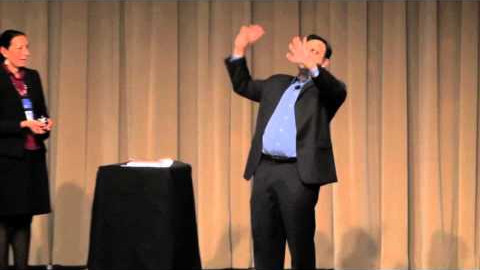Improve Problem Solving by Avoiding “Binary Thinking”
Avoiding binary thinking is the key to being a better problem solver. In this video, Avish explains what “binary thinking” is and how avoiding it is one of the strongest creativity and problem solving techniques you can use (Transcription below).
Does Your Team, Organization, or Association Need Help Breaking Out of Binary Thinking?
If so, one of Avish’s interactive, high-energy, high-fun, and high-content programs can help!
Using ideas from the world of improv comedy, Avish works with groups to help them access their creativity, think beyond the first option, and be open to exploring new possibilities.
For more info, read about Avish’s motivational keynote speaker programs and business training workshops, or watch his funny motivational speaker videos!
Transcription
Quick question: Heads or Tails?
Heads!
Which one did you say? You know what? I don’t really care, it doesn’t really matter. I’m flipping this coin to demonstrate “binary choices.” A coin either is heads or tails. It’s binary. It’s “either/or.” Now a coin can be a great way to make a decision when you’re uncertain, however when it comes to problem solving, binary thinking like you get in a coin can be totally destructive in solving problems.
Solving problems is difficult when there’s no “yes” or “no” answer. In fact if there’s an easy “yes” or “no” answer it’s probably not much of a problem because you could just pick “yes” or “no” and move on.
Most problems in our lives are much more complicated than “either/or” or “yes” or “no” type answers. The problem is as human beings, we tend to fall into that “either/or” paradigm. We fall into binary thinking. Now binary is a term for computers and yes, go figure, I’m an Indian man. I have a degree in computer engineering. It’s almost required. But binary comes from the world of computers where everything comes down to 0s and 1s. I’m not going to explain the technicals of it but at the core, everything is either a zero or a one. There’s no other option. That’s binary and it works for computers but it doesn’t work so well for critical thinking and problem solving. In fact, breaking out of that “either/or” or “yes” or “no” paradigm is the exact key you need to become a more effective problem solver.
I had an experience with this when I was hosting an improv comedy show. [Video Clip]
In that exercise you saw Patrick asking the audience for suggestions and sentences. Now here’s the thing: I play that game a lot. In fact, in my keynote presentations, I end most of my speeches with that – It’s a game called “blind line.” Now normally what I do is I put out cards and pens for the audience to write things down on. Well this was a different type of show for me and there was a lot going on. I forgot to put out the cards I had brought. So halfway through that show the game was coming up and some of us who were off-stage, Patrick and myself, I say “oh man I forgot to put the cards out – that’s fine. We’ll just skip that game.” Now this was me following the binary. I was like, “this is how I usually do it, I put the cards out. I didn’t.” That’s “yes” or “no” and since I didn’t, we move on.
Now Patrick stopped and said “oh no, it’ll be fine, what we’ll do is that we’ll send out of the room the people who are going to play the game, and then I’ll ask the audience to provide some of those sentences for us while you guys are out so you won’t know what those sentences are.” And it was so simple and in that case it took Patrick to bring me out and say “no no, there’s more than two options and you need to go with it.”
Off stage, in your own life, in your own business, you’re going to face these same kind of situations. You have a plan, something happens and sends you off your plan, you then have the choice- you can say “yes” or “no” or you can step back, and I’m advising for great problem solving: step back and ask yourself, “what else can I do? How else can I solve this problem? What are some other options I can come up with?” Really catch yourself when you get into that head down yes or no binary mode. That is going to be the key in improving your problem solving in every area of your life.
Some examples of binary thinking:
A or B.
Yes or No.
True or False.
My way or your way.
My way or the high way.
Beatles or the Rolling Stones.
Is it Live or is it Memorex? (You young people here have no idea what that is. Look it up.) Mary Ann or Ginger?
And of course, everyone’s favorite – Team Edward or Team Jacob? Ohhh Jacob, you’re so dreamy!!
For more info on how Avish can help your team or organization avoid binary thinking, read about his motivational keynote speaker programs and business training workshops, or watch his funny motivational speaker videos!













 RSS
RSS Email
Email




